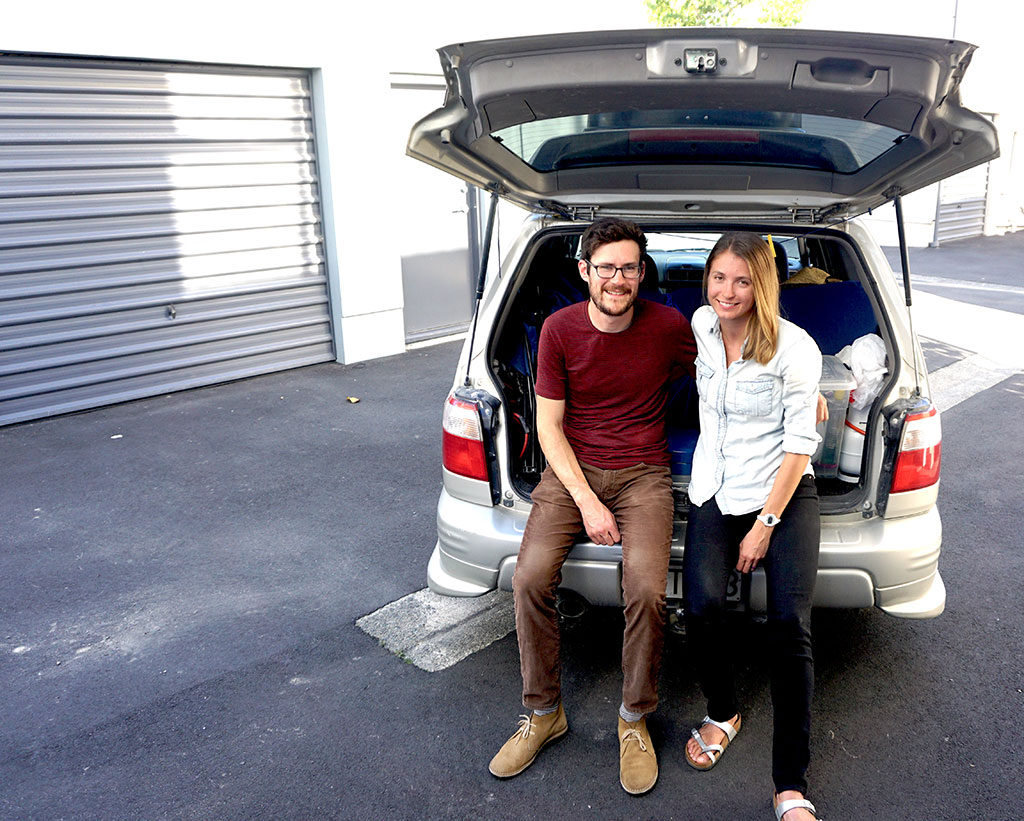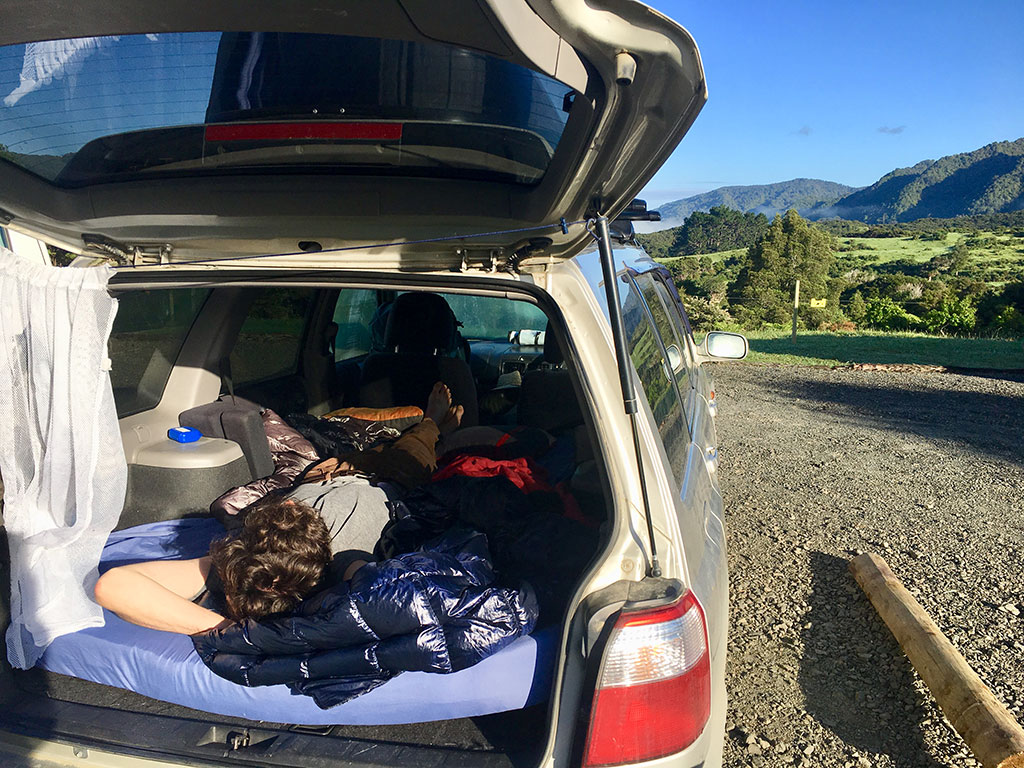From a distance, living with your significant other in a vehicle seems pretty darn romantic. Social media feeds are filled with idealized #VanLife photos—you know the kind—featuring four sets of toes dangling off the edge of a Pendleton blanket, while the setting sun filters through two glasses of wine sitting on a shelf that seems to exist just so the occupants can drink rosé in bed. (No judgment there.)
In reality, sharing a confined space with another human being can put serious strains on your relationship, no matter how much tolerance you build for your partner’s snoring or smelly feet. After nearly six months traveling around New Zealand with my husband in an old Subaru Forester (which, yes, is even cozier than a van), I’ve learned a few things about maintaining relationship harmony in small spaces and over long distances.

Caitlin and her husband, Michael, in their Subaru Forester. (Photo Credit: Caitlin Moran)
Decide where your stuff ‘lives’
I know what you’re thinking: We have, like, 8 square feet of living space. How could we possibly lose something? Trust me: From backseat pockets to glove compartments to that hidden trap door with the spare tire, the average vehicle has about 5,000 different nooks and crannies for stashing stuff. That’s a good thing, until you roll up in a field full of biting insects and can’t find the bug spray.
Organization is a necessary part of maintaining peace between you and your partner. The easiest solution? Select a location for everything, and then make sure you communicate that with one another. Clear plastic bins are great for organizing cooking supplies and food, while smaller reusable containers ensure you won’t lose your stove lighter (and your mind) at the bottom of your bigger cookware bin.
Keep your personal belongings in your own separate bags or bins, but avoid stashing something you both might need—like a phone charger—deep in your personal pack. Traveling with skis, surfboards or climbing gear? Using a rack or cargo box to keep your activity-specific equipment separate from everyday items will help your home on wheels feel more like a home and less like a gear closet. And, when all else fails, remember that phrasing makes a big difference. “Hey, have you seen my blue hoodie?” is a lot less rage-inducing than, “Where the F did you put my clothes?”

Photo Credit: Caitlin Moran
Fine-tune your budget
If you’re living or traveling in a van, you’re probably trying to get by with spending as little as possible. Unfortunately, “let’s not buy anything” is neither practical nor is it a substitute for an actual budget. You still have to eat, and the landscape between instant ramen and five-star restaurant meals is vast.
Budgeting was an integral part of how my husband and I prepared for our trip abroad, but after arriving in New Zealand, we soon discovered we had not drilled down into specific increments. A monthly total of $2,000 seems like a really vague number when you’re deciding whether to buy the $6 bottle of wine or $10 bottle of wine.
For the first month or so, we paid closer attention to how much we were spending each week, as well as how our expenses broke down by type (gas, food, fun money, etc.). This helped put both smaller and bigger purchases into perspective, and gave us a sense of where we should be at different points in the month in order to stay under budget. We kept our target numbers in a spreadsheet and used a simple smartphone app to keep a running tally of our expenses.
It took time and communication to decide how and when to splurge on purchases. We gradually worked into a routine of one non-supermarket treat a day, like coffee or ice cream, and ate in restaurants once or twice a week. Your arrangement will vary based on your destination and how much sampling the local cuisine factors into your itinerary, but it’s best to talk through those expectations as soon as possible—ideally before your trip begins—and revisit the conversation as needed.
Finally, this should go without saying: Hangry van life is the absolute worst kind of van life. A cache of emergency snacks will go a long way in stopping arguments before they start.
Take a break when you need it
Even the strongest of pairs needs alone time. Living out of a vehicle means you can’t sequester yourself in another room whenever you feel like it, which makes it important to intentionally schedule some me time.
Taking a break doesn’t require physical distance from your partner. Transportation logistics can make it a challenge for one person to go off and do something alone, and my husband and I found we were interested in the same activities more often than not.

Photo Credit: Caitlin Moran
Instead, we tried to fit in an hour of individual quiet time before dinner. We used this time to read, go for a solo walk or just relax—without interruption and without any pressure to jump into another activity.
Of course, sometimes it’s not the other person who is driving you crazy; it’s the fact that you haven’t showered in several days and can’t remember the last time you slept in a real bed. You know, the kind with box springs and everything.
No one will revoke your dirtbag card if you decide to stay in a hostel or even—gasp—a hotel every once in awhile. Van life is a marathon, not a sprint, and tending to one another’s health and happiness is what will keep you both in it for the long haul.
